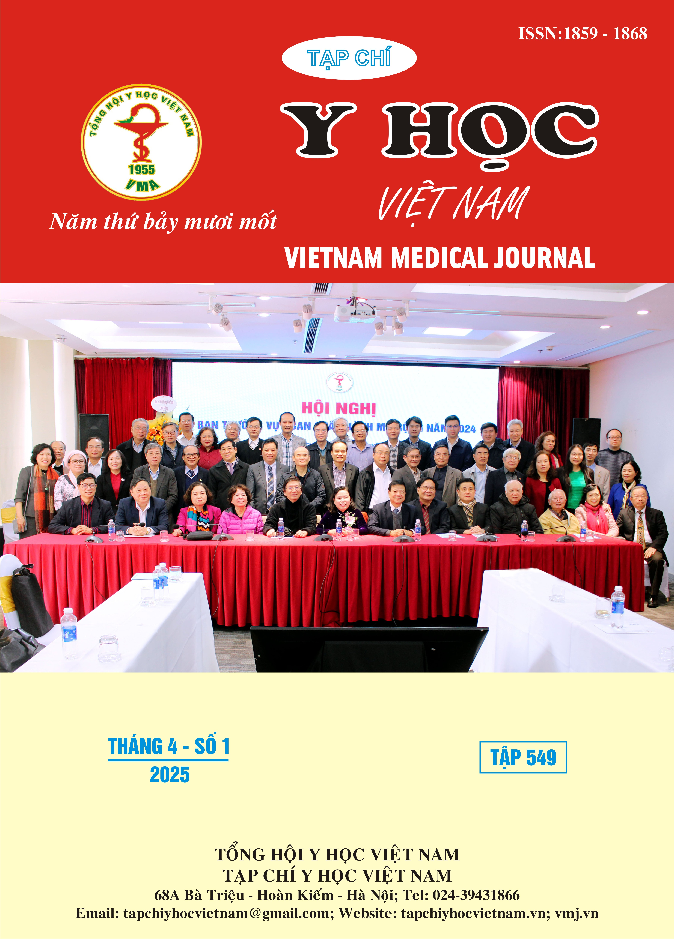ĐỀ XUẤT HỆ THỐNG PHÂN LOẠI CÁC DẠNG NHÁNH CHI PHỐI CHO CƠ THANG CỦA THẦN KINH PHỤ
Nội dung chính của bài viết
Tóm tắt
Mục tiêu: Phân loại các dạng nhánh chi phối cơ thang của thần kinh phụ trên xác người Việt Nam trưởng thành. Phương pháp: Báo cáo hàng loạt ca; thực hiện trên 18 mẫu cơ thang từ 9 xác người Việt trưởng thành bảo quản đông lạnh tại bộ môn giải phẫu trường Đại học Y khoa Phạm Ngọc Thạch từ tháng 9/2024 đến 1/2025. Phẫu tích khảo sát đường đi thần kinh phụ đoạn từ tam giác cổ sau đến mặt bụng cơ thang, ghi nhận đặc điểm hình thái các nhánh sơ cấp tách ra từ thân chính thần kinh phụ. Kết quả: Nghiên cứu ghi nhận 100% trường hợp có sự hiện diện nhánh sơ cấp của thần kinh phụ đi vào cơ thang. Số nhánh sơ cấp trung bình là 7,9 ± 2,5. Về vị trí, phần lớn các nhánh sơ cấp đi vào bụng cơ chiếm tỷ lệ cao nhất (90,1%). Hình thái các nhánh sơ cấp được ghi nhận có 2 dạng, trong đó đa số là dạng 1 chiếm 81,7%. Ngoài ra, nghiên cứu còn ghi nhận thân chính tách ra nhánh đi vào bờ trước cơ thang chiếm 11,2%. Kết luận: Phân bố các nhánh thần kinh phụ trên cơ thang có sự đa dạng và phức tạp. Vì vậy cần thêm những nghiên cứu định vị điểm thần kinh vào cơ bằng hệ trục tọa độ trên bề mặt da.
Chi tiết bài viết
Từ khóa
Nhánh sơ cấp của thần kinh phụ, cơ thang, hội chứng đau cơ mạc
Tài liệu tham khảo
2. Caneiro JP, O’Sullivan P, Burnett A, Barach A, O’Neil D, Tveit O, et al. The influence of different sitting postures on head/neck posture and muscle activity. Man Ther. 2010 Feb;15(1):54–60.
3. Treaster D, Marras WS, Burr D, Sheedy JE, Hart D. Myofascial trigger point development from visual and postural stressors during computer work. J Electromyogr Kinesiol. 2006 Apr;16(2):115–24.
4. Cagnie B, Dhooge F, Van Akeleyen J, Cools A, Cambier D, Danneels L. Changes in microcirculation of the trapezius muscle during a prolonged computer task. Eur J Appl Physiol. 2012 Sep;112(9):3305–12.
5. Travell JG, Simons DG. Myofascial pain and dysfunction: the trigger point manual. vol 2. Lippincott Williams & Wilkins; 1999.
6. Lloyd S. Accessory nerve: anatomy and surgical identification. J Laryngol Otol. 2007 Dec;121(12): 1118–25.
7. Wang JW, Zhang WB, Li F, Fang X, Yi ZQ, Xu XL, et al. Anatomy and clinical application of suprascapular nerve to accessory nerve transfer. World J Clin Cases. 2022 Sep 26;10(27):9628–40.
8. Shiozaki K, Abe S, Agematsu H, Mitarashi S, Sakiyama K, Hashimoto M, et al. Anatomical study of accessory nerve innervation relating to functional neck dissection. J Oral Maxillofac Surg. 2007 Jan;65(1):22–9.
9. Antonius C. Kierner IZ. How do the cervical plexus and the spinal accessory nerve contribute to the innervation of the trapezius muscle ? Arch Otolaryngol Head Neck Surg. 2001;127:1230–2.
10. Akamastsu FE; S. Anatomical basis of the myofascial trigger points of the trapezius muscle. Int J Morphol. 2013;31(3):015–920.


